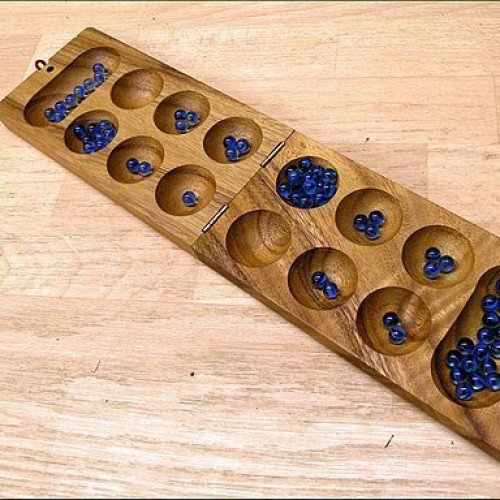CAMELOT VS KALAH

CAMELOT
Camelot is a strategy board game for two players. It was invented by George S. Parker late in the 19th century, and was one of the first games published by Parker Brothers, originally under the name Chivalry. The game was reissued as "Camelot" in 1930, with reduced size and number of pieces. It flourished through numerous editions and variants, achieving its greatest popularity in the 1930s, and remained in print through the late 1960s. Parker Brothers briefly republished the game in the 1980s under the name Inside Moves. Since then it has been out of print, but retains a core of fans anticipating another revival. Camelot is easy to learn and without extensive theory or praxis, making it perhaps more accessible for novices to play/enjoy compared to chess. Gameplay is exceptionally tactical almost from the first move, so games are quick to play to a finish. A World Camelot Federation exists, with free membership, led by Michael W. Nolan. Camelot was featured in Abstract Games magazine in 2001 and 2002. In 1882, George S. Parker began working on an abstract board game called Chivalry. His goal was to create a game not so difficult as chess, but considerably more varied than checkers. Parker created a game that was a complex, tactical, but an easily learned and quickly played mixture of Halma and checkers. When finally published by Geo. S. Parker & Co. in 1887, Chivalry won the raves of chess and checkers experts, but the game Parker called "the best game in 2000 years" did not catch on quickly with the general public. However, Parker never lost his enthusiasm for the game, and in 1930 he made a few changes, and Parker Brothers republished it under the name "Camelot". A few more rules changes followed in 1931. Camelot enjoyed its greatest popularity in the 1930s. Camelot players included José Raúl Capablanca, World Chess Champion from 1921 to 1927, and Frank Marshall, U.S. Chess Champion from 1907 to 1936. Sidney Lenz and Milton Work, two world-famous bridge players, also played the game. There were over 50 different editions of Camelot sets issued, including a gold-stamped leather edition and a mahogany cabinet edition. There were tournament editions, regular editions, and low-cost editions. Camelot was eventually discontinued in 1968, then reissued as "Inside Moves" in 1985, and finally discontinued again in 1986.
Statistics for this Xoptio

KALAH
Kalah, also called Kalaha or Mancala, is a game in the mancala family invented in the United States by William Julius Champion, Jr. in 1940. This game is sometimes also called "Kalahari", possibly by false etymology from the Kalahari desert in Namibia. As the most popular and commercially available variant of mancala in the West, Kalah is also sometimes referred to as Warri or Awari, although those names more properly refer to the game Oware. For most of its variations, Kalah is a solved game with a first-player win if both players play perfect games. The Pie rule can be used to balance the first-player's advantage. Mark Rawlings has written a computer program to extensively analyze both the "standard" version of Kalah and the "empty capture" version, which is the primary variant. The analysis was made possible by the creation of the largest endgame databases ever made for Kalah. They include the perfect play result of all 38,902,940,896 positions with 34 or fewer seeds. In 2015, for the first time ever, each of the initial moves for the standard version of Kalah(6,4) and Kalah(6,5) have been quantified: Kalah(6,4) is a proven win by 8 for the first player and Kalah(6,5) is a proven win by 10 for the first player. In addition, Kalah(6,6) with the standard rules has been proven to be at least a win by 4. Further analysis of Kalah(6,6) with the standard rules is ongoing. For the "empty capture" version, Geoffrey Irving and Jeroen Donkers (2000) proved that Kalah(6,4) is a win by 10 for the first player with perfect play, and Kalah(6,5) is a win by 12 for the first player with perfect play. Anders Carstensen (2011) proved that Kalah(6,6) was a win for the first player. Mark Rawlings (2015) has extended these "empty capture" results by fully quantifying the initial moves for Kalah(6,4), Kalah(6,5), and Kalah(6,6). With searches totaling 106 days and over 55 trillion nodes, he has proven that Kalah(6,6) is a win by 2 for the first player with perfect play. This was a surprising result, given that the "4-seed" and "5-seed" variations are wins by 10 and 12, respectively. Kalah(6,6) is extremely deep and complex when compared to the 4-seed and 5-seed variations, which can now be solved in a fraction of a second and less than a minute, respectively.